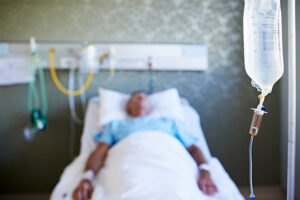Oncology
Multiple Myeloma
Comorbidities and Candidacy for Chimeric Antigen Receptor T-Cell Therapy vs Autologous Stem Cell Transplantation
Patients who are older and more comorbid than those who are typically considered for autologous stem cell transplantation may nevertheless be good candidates for chimeric antigen receptor (CAR) T-cell therapy. An assessment for possible placement on the CAR T-cell therapy pathway should occur at the earliest opportunity.
When we begin to compare the eligibility criteria for CAR T-cell therapy vs that for transplant, the criteria for CAR T-cell therapy are actually more inclusive, allowing more patients to access this treatment. For example, I took an 82-year-old patient to receive CAR T-cell therapy a few months ago. They developed a little bit of early grade 1 cytokine release syndrome (CRS), but otherwise they did fine.
A major reason for not considering the use of CAR T-cell therapy relates to cardiac function. We know that CRS is a possibility, so there are potential concerns related to an increased heart rate and, potentially, a drop in blood pressure, along with the use of a fair amount of fluids in those with atherosclerotic disease or underlying heart failure. Thus, I am more hesitant to use CAR T-cell therapy in such patients. However, for those with a good performance status and who are able to perform most of their activities of daily living, I am generally very comfortable with CAR T-cell therapy, regardless of age.
In terms of transplant, there are misperceptions regarding age and eligibility in the induction therapy setting. An age cutoff of 65 years, which is very arbitrary, is being used in Europe. For me, whether a patient can tolerate a transplant depends on the individual’s physical condition, their comorbidities, and the general risks of the procedure.
Regarding immune reconstitution and its timing, there are some differences between transplantation and CAR T-cell therapy. With BCMA-directed CAR T-cell therapy, immune recovery certainly takes a bit longer. Immune recovery post transplant starts to occur within the first 3 months after transplant. Thus, we typically revaccinate our patients with COVID-19 and influenza vaccines at day 100 post transplant, although we wait almost 1 year before administering the childhood vaccines in patients who have received a transplant. For individuals on BCMA-directed CAR T-cell therapy, it will likely be 6 to 9 months before they begin to see an improvement in immune function.
We need to take precaution when administering CAR T cells to those with underlying neurologic conditions because of the potential for immune effector cell–associated neurotoxicity syndrome. For example, we should be cautious in patients with a CNS irritant, such as a large plasmacytoma that is abutting the meninges. For patients with a seizure disorder, we may want to partner with a neurologist in advance to optimize their anticonvulsant therapy to reduce the risk of seizure-related complications. In addition, early intervention with corticosteroids and the interleukin-6 inhibitor tocilizumab, in the case of CRS, is helpful to mitigate or abort these complications. For individuals with multiple myeloma who receive CAR T-cell therapy today, the development of grade 3 CRS is fairly rare. Most of us are very vigilant and timely in using tocilizumab at grade 1, so I think that we prevent many of the cases of CRS that might have historically become grade 3.
Finally, I think that it is important to note that, whenever CAR T-cell therapy is being considered, it takes time to secure a slot, complete the apheresis, and manufacture CAR T cells. If there is uncertainty about a patient’s candidacy for CAR T-cell therapy due to comorbidities, or if the decision is otherwise difficult to reach, it may be best to connect with a CAR T-cell center early. There, clinicians can make that determination and, if appropriate, set the process into motion.
Canonico D, Laubach J, Mo C, et al. Real world experience of patients treated with idecabtagene vicleucel: a BCMA-directed chimeric antigen receptor T-cell therapy for multiple myeloma [poster P-006]. Poster presented at: 19th International Myeloma Society Annual Meeting; August 25-27, 2022; Los Angeles, CA.
Costa LJ, Hungria V, Mohty M, Mateos M-V. How I treat triple-class refractory multiple myeloma. Br J Haematol. 2022;198(2):244-256. doi:10.1111/bjh.18185
Dhakal B, Shah N, Kansagra A, et al. ASTCT clinical practice recommendations for transplantation and cellular therapies in multiple myeloma. Transplant Cell Ther. 2022;28(6):284-293. doi:10.1016/j.jtct.2022.03.019
Kegyes D, Constantinescu C, Vrancken L, et al. Patient selection for CAR T or BiTE therapy in multiple myeloma: which treatment for each patient? J Hematol Oncol. 2022;15(1):78. doi:10.1186/s13045-022-01296-2
Maisnar V, Pour L, Spicka I, et al. Patient characteristics, treatment patterns, and outcomes in triple-class exposed relapsed/refractory multiple myeloma patients, a retrospective observational study using Czech registry data. Clin Lymphoma Myeloma Leuk. 2023;23(2):145-153. doi:10.1016/j.clml.2022.11.001
Perrot A. How I treat frontline transplantation-eligible multiple myeloma. Blood. 2022;139(19):2882-2888. doi:10.1182/blood.2020008735
Saad A, Mahindra A, Zhang M-J, et al. Hematopoietic cell transplant comorbidity index is predictive of survival after autologous hematopoietic cell transplantation in multiple myeloma. Biol Blood Marrow Transplant. 2014;20(3):402-408.e1. doi:10.1016/j.bbmt.2013.12.557
Stalker ME, Mark TM. Clinical management of triple-class refractory multiple myeloma: a review of current strategies and emerging therapies. Curr Oncol. 2022;29(7):4464-4477. doi:10.3390/curroncol29070355











